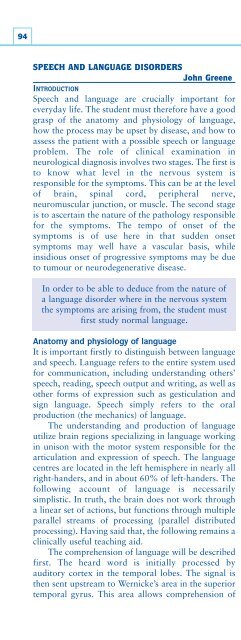You also want an ePaper? Increase the reach of your titles
YUMPU automatically turns print PDFs into web optimized ePapers that Google loves.
94SPEECH AND LANGUAGE DISORDERSJohn GreeneINTRODUCTIONSpeech and language are crucially important foreveryday life. The student must therefore have a goodgrasp of the anatomy and physiology of language,how the process may be upset by disease, and how toassess the patient with a possible speech or languageproblem. The role of clinical examination inneurological diagnosis involves two stages. The first isto know what level in the nervous system isresponsible for the symptoms. This can be at the levelof brain, spinal cord, peripheral nerve,neuromuscular junction, or muscle. The second stageis to ascertain the nature of the pathology responsiblefor the symptoms. The tempo of onset of thesymptoms is of use here in that sudden onsetsymptoms may well have a vascular basis, whileinsidious onset of progressive symptoms may be dueto tumour or neurodegenerative disease.In order to be able to deduce from the nature ofa language disorder where in the nervous systemthe symptoms are arising from, the student mustfirst study normal language.Anatomy and physiology of languageIt is important firstly to distinguish between languageand speech. Language refers to the entire system usedfor communication, including understanding others’speech, reading, speech output and writing, as well asother forms of expression such as gesticulation andsign language. Speech simply refers to the oralproduction (the mechanics) of language.The understanding and production of languageutilize brain regions specializing in language workingin unison with the motor system responsible for thearticulation and expression of speech. The languagecentres are located in the left hemisphere in nearly allright-handers, and in about 60% of left-handers. Thefollowing account of language is necessarilysimplistic. In truth, the brain does not work througha linear set of actions, but functions through multipleparallel streams of processing (parallel distributedprocessing). Having said that, the following remains aclinically useful teaching aid.The comprehension of language will be describedfirst. The heard word is initially processed byauditory cortex in the temporal lobes. The signal isthen sent upstream to Wernicke’s area in the superiortemporal gyrus. This area allows comprehension oflanguage and initiation of speech output. This is thenpassed forward to Broca’s area (inferior frontalgyrus), which is responsible for supervising theproduction of language (86). Adjacent motor cortexthen prepares the motor act of speech, and signals aresent down cortico-bulbar fibres to the musclescontrolling speech. These descending fibres aremodulated by the cerebellum and basal ganglia andterminate on motor nuclei of cranial nervescontrolling tongue and larynx. The appropriatemuscle action results in desired articulation andspeech (87).Reading and writingReading differs from listening in that the occipitalcortex processes language visually. Information isthen passed forward to Wernicke’s area forunderstanding of what is being read. Normalprocessing of written material involves two processes.One is a superficial system in which words are readand pronounced simply on the basis of the letterstrings, e.g. MINT is pronounced as one wouldexpect from the component letters. For the other(deep) system, correct pronunciation is intimately tiedup with meaning, e.g. PINT can only be correctlypronounced if the patient knows the meaning of theword. With a regular word such as MINT, there is nodisparity between the superficial and deep systems.With irregular words such as PINT, there is adisparity in pronunciation between the surface and86BAAFSMGWAAG86 Diagram illustrating the principal language areas of thebrain. AF: arcuate fasciculus; AG: angular gyrus; BA: Broca’sarea; SMG: supra marginal gyrus; WA: Wernicke’s area.
















